Critique of a Quantitative Study on Smoking Cessation Using a Smartphone Application
VerifiedAdded on 2022/12/27
|5
|1169
|65
AI Summary
This article provides a critique of a quantitative study on smoking cessation using a smartphone application with a carbon monoxide checker. It discusses the rigour and bias in the study, internal validity and limitations, compliance/adherence with the intervention, and concludes with the potential of digital therapy for smoking cessation.
Contribute Materials
Your contribution can guide someone’s learning journey. Share your
documents today.
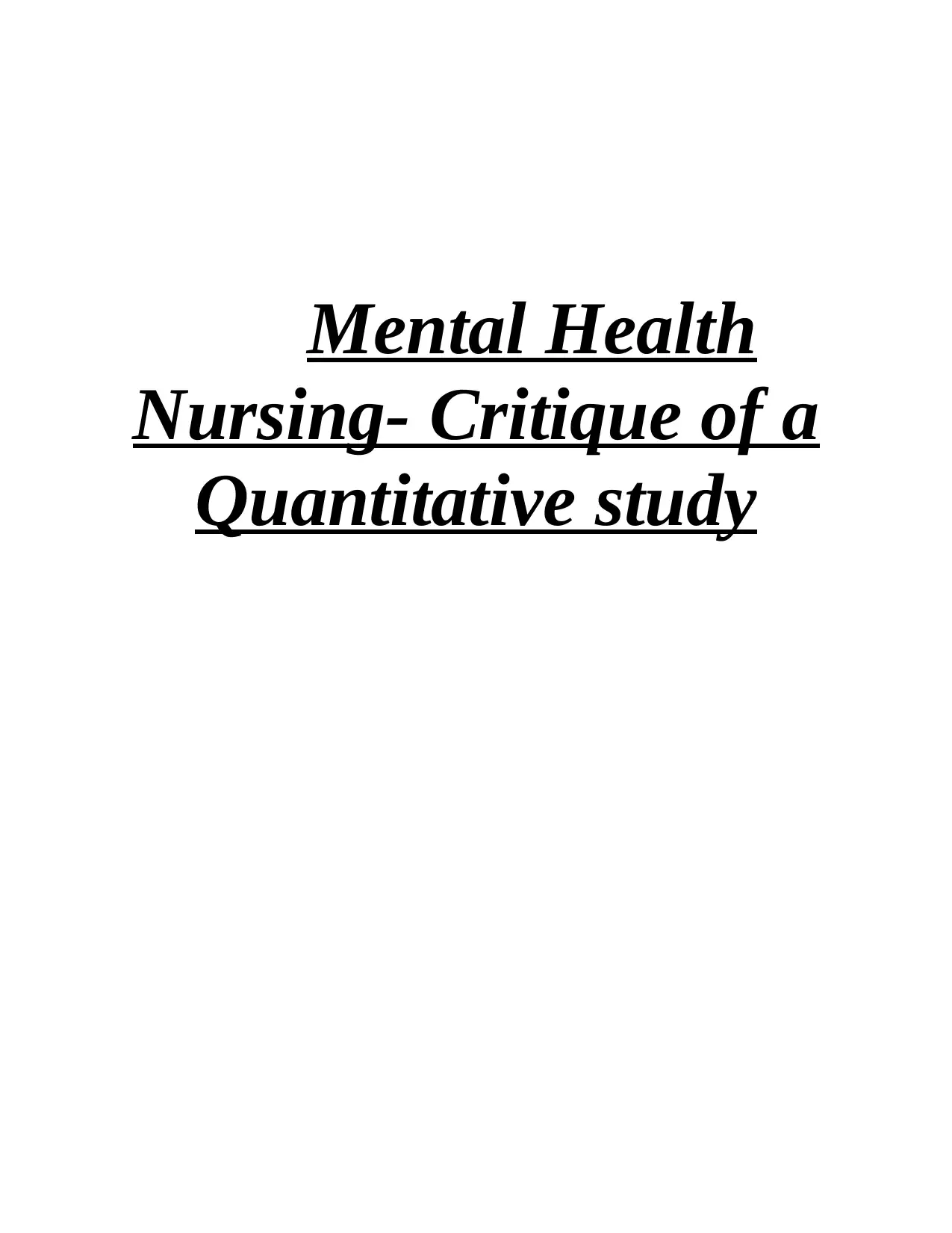
Mental Health
Nursing- Critique of a
Quantitative study
Nursing- Critique of a
Quantitative study
Secure Best Marks with AI Grader
Need help grading? Try our AI Grader for instant feedback on your assignments.
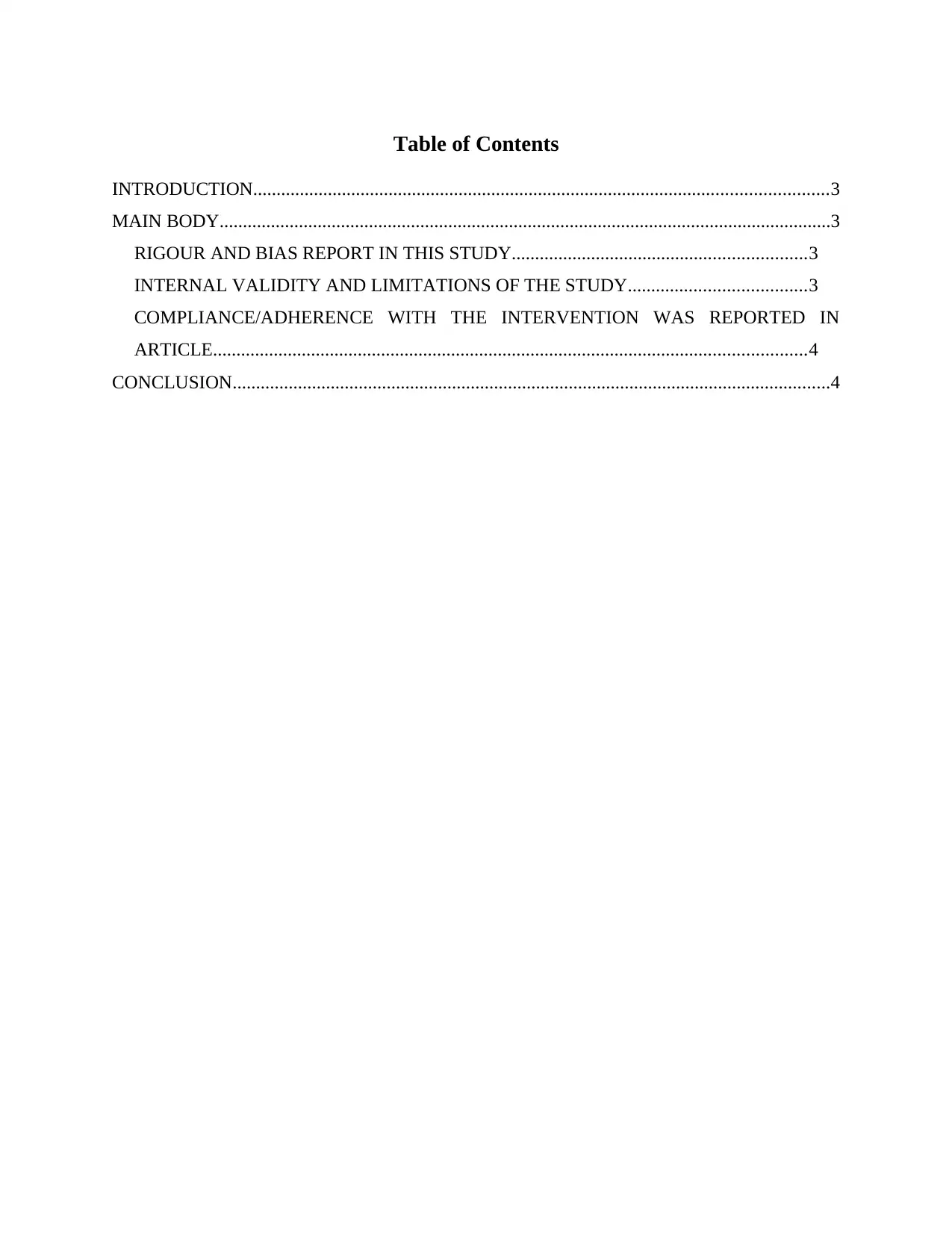
Table of Contents
INTRODUCTION...........................................................................................................................3
MAIN BODY...................................................................................................................................3
RIGOUR AND BIAS REPORT IN THIS STUDY...............................................................3
INTERNAL VALIDITY AND LIMITATIONS OF THE STUDY......................................3
COMPLIANCE/ADHERENCE WITH THE INTERVENTION WAS REPORTED IN
ARTICLE...............................................................................................................................4
CONCLUSION................................................................................................................................4
INTRODUCTION...........................................................................................................................3
MAIN BODY...................................................................................................................................3
RIGOUR AND BIAS REPORT IN THIS STUDY...............................................................3
INTERNAL VALIDITY AND LIMITATIONS OF THE STUDY......................................3
COMPLIANCE/ADHERENCE WITH THE INTERVENTION WAS REPORTED IN
ARTICLE...............................................................................................................................4
CONCLUSION................................................................................................................................4
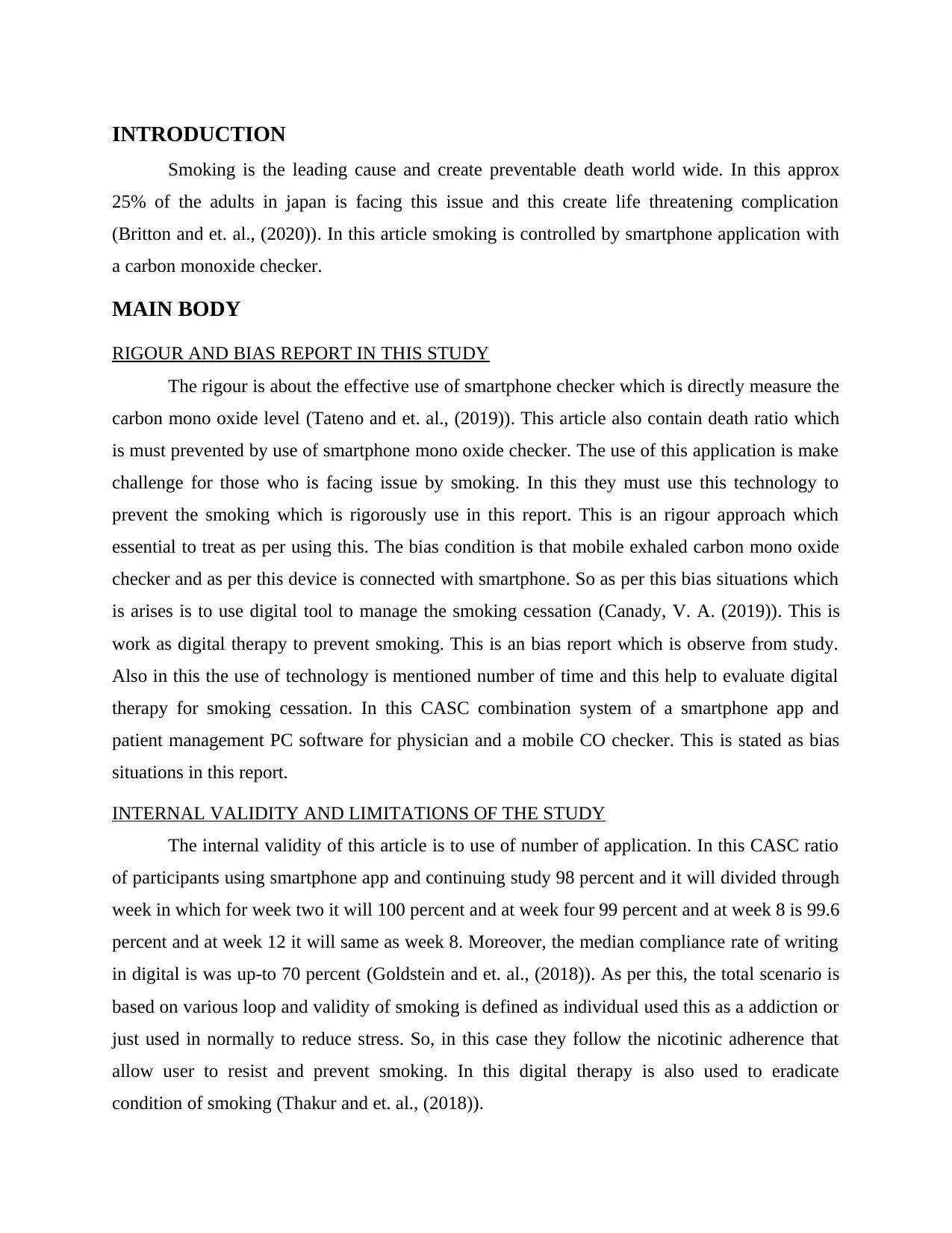
INTRODUCTION
Smoking is the leading cause and create preventable death world wide. In this approx
25% of the adults in japan is facing this issue and this create life threatening complication
(Britton and et. al., (2020)). In this article smoking is controlled by smartphone application with
a carbon monoxide checker.
MAIN BODY
RIGOUR AND BIAS REPORT IN THIS STUDY
The rigour is about the effective use of smartphone checker which is directly measure the
carbon mono oxide level (Tateno and et. al., (2019)). This article also contain death ratio which
is must prevented by use of smartphone mono oxide checker. The use of this application is make
challenge for those who is facing issue by smoking. In this they must use this technology to
prevent the smoking which is rigorously use in this report. This is an rigour approach which
essential to treat as per using this. The bias condition is that mobile exhaled carbon mono oxide
checker and as per this device is connected with smartphone. So as per this bias situations which
is arises is to use digital tool to manage the smoking cessation (Canady, V. A. (2019)). This is
work as digital therapy to prevent smoking. This is an bias report which is observe from study.
Also in this the use of technology is mentioned number of time and this help to evaluate digital
therapy for smoking cessation. In this CASC combination system of a smartphone app and
patient management PC software for physician and a mobile CO checker. This is stated as bias
situations in this report.
INTERNAL VALIDITY AND LIMITATIONS OF THE STUDY
The internal validity of this article is to use of number of application. In this CASC ratio
of participants using smartphone app and continuing study 98 percent and it will divided through
week in which for week two it will 100 percent and at week four 99 percent and at week 8 is 99.6
percent and at week 12 it will same as week 8. Moreover, the median compliance rate of writing
in digital is was up-to 70 percent (Goldstein and et. al., (2018)). As per this, the total scenario is
based on various loop and validity of smoking is defined as individual used this as a addiction or
just used in normally to reduce stress. So, in this case they follow the nicotinic adherence that
allow user to resist and prevent smoking. In this digital therapy is also used to eradicate
condition of smoking (Thakur and et. al., (2018)).
Smoking is the leading cause and create preventable death world wide. In this approx
25% of the adults in japan is facing this issue and this create life threatening complication
(Britton and et. al., (2020)). In this article smoking is controlled by smartphone application with
a carbon monoxide checker.
MAIN BODY
RIGOUR AND BIAS REPORT IN THIS STUDY
The rigour is about the effective use of smartphone checker which is directly measure the
carbon mono oxide level (Tateno and et. al., (2019)). This article also contain death ratio which
is must prevented by use of smartphone mono oxide checker. The use of this application is make
challenge for those who is facing issue by smoking. In this they must use this technology to
prevent the smoking which is rigorously use in this report. This is an rigour approach which
essential to treat as per using this. The bias condition is that mobile exhaled carbon mono oxide
checker and as per this device is connected with smartphone. So as per this bias situations which
is arises is to use digital tool to manage the smoking cessation (Canady, V. A. (2019)). This is
work as digital therapy to prevent smoking. This is an bias report which is observe from study.
Also in this the use of technology is mentioned number of time and this help to evaluate digital
therapy for smoking cessation. In this CASC combination system of a smartphone app and
patient management PC software for physician and a mobile CO checker. This is stated as bias
situations in this report.
INTERNAL VALIDITY AND LIMITATIONS OF THE STUDY
The internal validity of this article is to use of number of application. In this CASC ratio
of participants using smartphone app and continuing study 98 percent and it will divided through
week in which for week two it will 100 percent and at week four 99 percent and at week 8 is 99.6
percent and at week 12 it will same as week 8. Moreover, the median compliance rate of writing
in digital is was up-to 70 percent (Goldstein and et. al., (2018)). As per this, the total scenario is
based on various loop and validity of smoking is defined as individual used this as a addiction or
just used in normally to reduce stress. So, in this case they follow the nicotinic adherence that
allow user to resist and prevent smoking. In this digital therapy is also used to eradicate
condition of smoking (Thakur and et. al., (2018)).
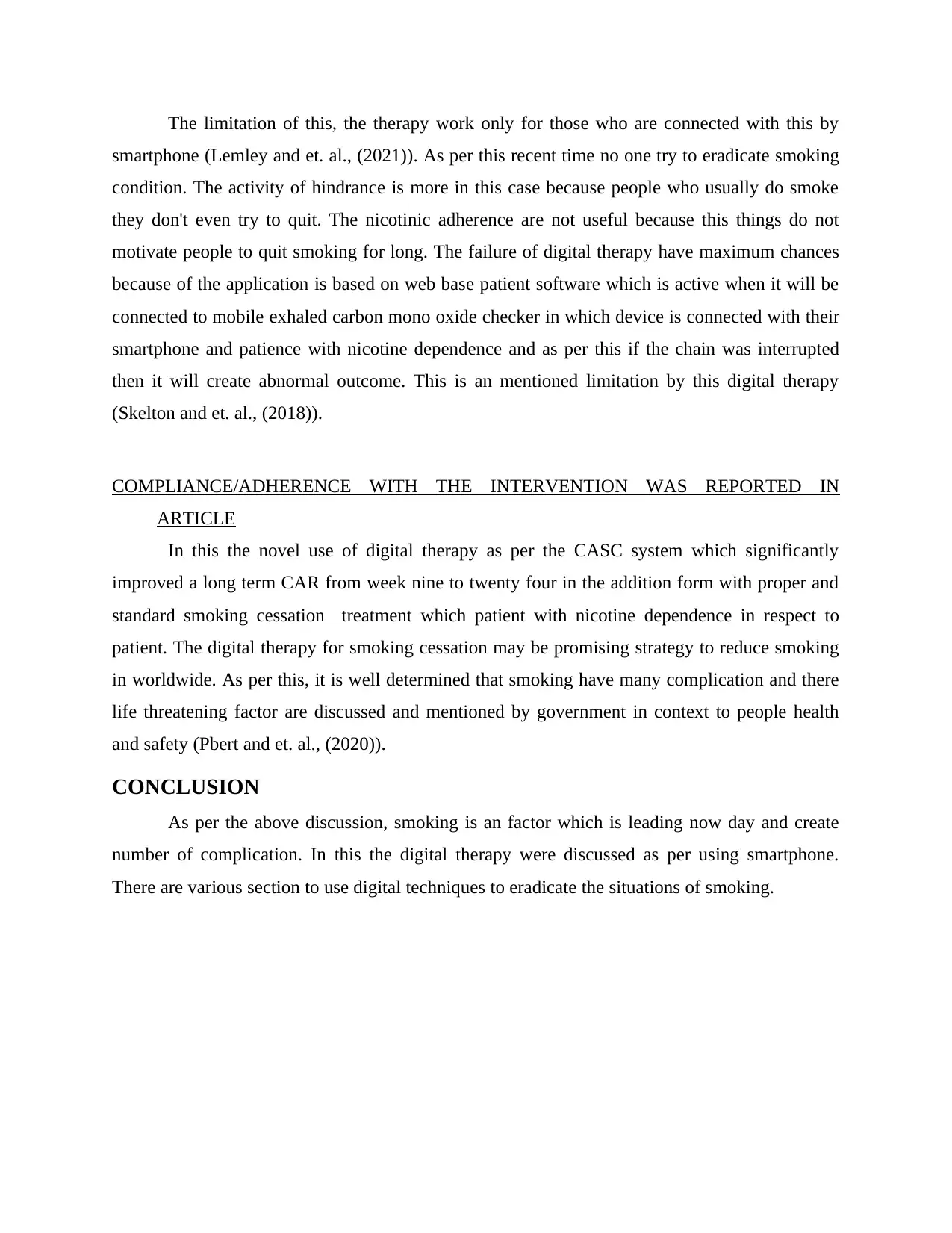
The limitation of this, the therapy work only for those who are connected with this by
smartphone (Lemley and et. al., (2021)). As per this recent time no one try to eradicate smoking
condition. The activity of hindrance is more in this case because people who usually do smoke
they don't even try to quit. The nicotinic adherence are not useful because this things do not
motivate people to quit smoking for long. The failure of digital therapy have maximum chances
because of the application is based on web base patient software which is active when it will be
connected to mobile exhaled carbon mono oxide checker in which device is connected with their
smartphone and patience with nicotine dependence and as per this if the chain was interrupted
then it will create abnormal outcome. This is an mentioned limitation by this digital therapy
(Skelton and et. al., (2018)).
COMPLIANCE/ADHERENCE WITH THE INTERVENTION WAS REPORTED IN
ARTICLE
In this the novel use of digital therapy as per the CASC system which significantly
improved a long term CAR from week nine to twenty four in the addition form with proper and
standard smoking cessation treatment which patient with nicotine dependence in respect to
patient. The digital therapy for smoking cessation may be promising strategy to reduce smoking
in worldwide. As per this, it is well determined that smoking have many complication and there
life threatening factor are discussed and mentioned by government in context to people health
and safety (Pbert and et. al., (2020)).
CONCLUSION
As per the above discussion, smoking is an factor which is leading now day and create
number of complication. In this the digital therapy were discussed as per using smartphone.
There are various section to use digital techniques to eradicate the situations of smoking.
smartphone (Lemley and et. al., (2021)). As per this recent time no one try to eradicate smoking
condition. The activity of hindrance is more in this case because people who usually do smoke
they don't even try to quit. The nicotinic adherence are not useful because this things do not
motivate people to quit smoking for long. The failure of digital therapy have maximum chances
because of the application is based on web base patient software which is active when it will be
connected to mobile exhaled carbon mono oxide checker in which device is connected with their
smartphone and patience with nicotine dependence and as per this if the chain was interrupted
then it will create abnormal outcome. This is an mentioned limitation by this digital therapy
(Skelton and et. al., (2018)).
COMPLIANCE/ADHERENCE WITH THE INTERVENTION WAS REPORTED IN
ARTICLE
In this the novel use of digital therapy as per the CASC system which significantly
improved a long term CAR from week nine to twenty four in the addition form with proper and
standard smoking cessation treatment which patient with nicotine dependence in respect to
patient. The digital therapy for smoking cessation may be promising strategy to reduce smoking
in worldwide. As per this, it is well determined that smoking have many complication and there
life threatening factor are discussed and mentioned by government in context to people health
and safety (Pbert and et. al., (2020)).
CONCLUSION
As per the above discussion, smoking is an factor which is leading now day and create
number of complication. In this the digital therapy were discussed as per using smartphone.
There are various section to use digital techniques to eradicate the situations of smoking.
Secure Best Marks with AI Grader
Need help grading? Try our AI Grader for instant feedback on your assignments.
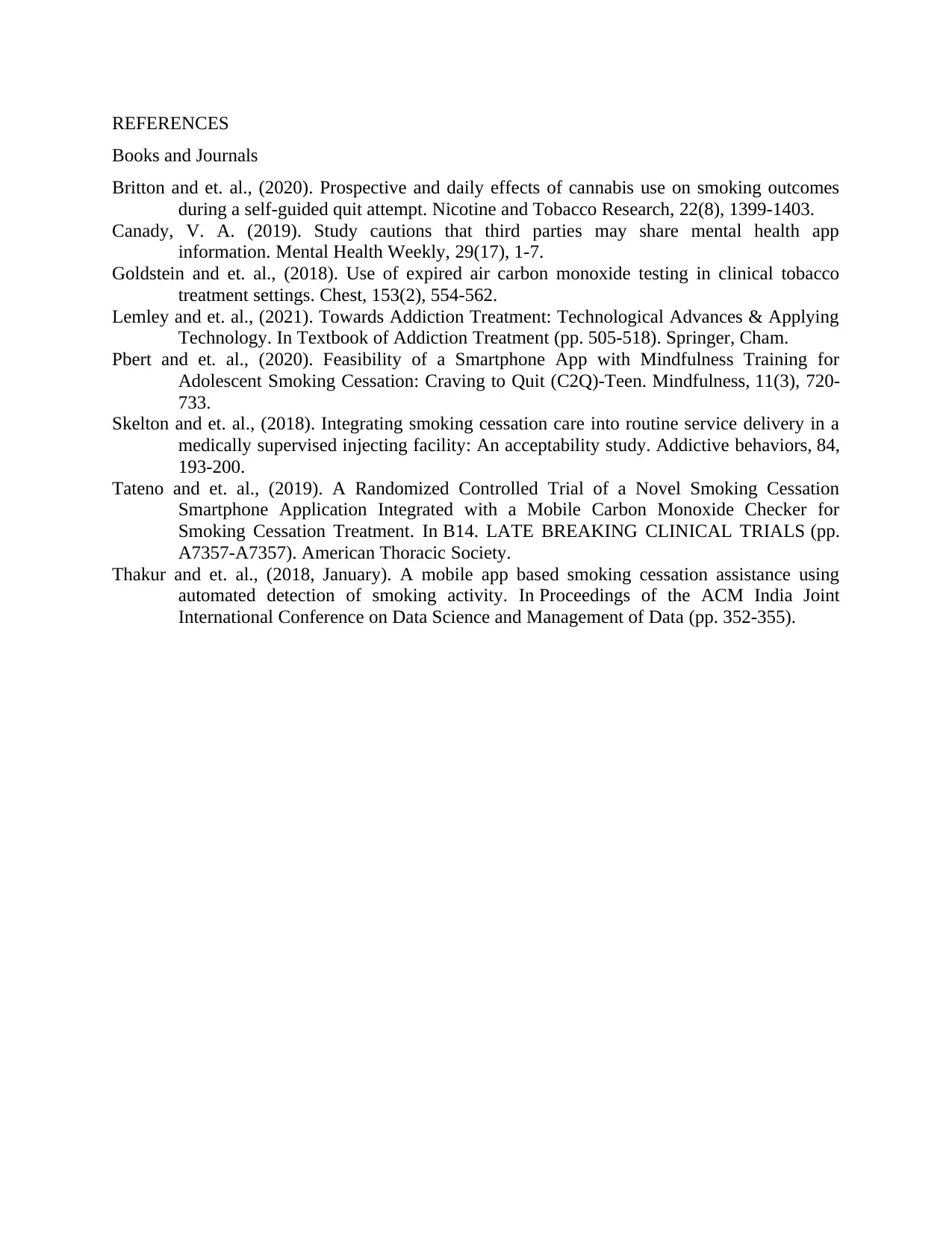
REFERENCES
Books and Journals
Britton and et. al., (2020). Prospective and daily effects of cannabis use on smoking outcomes
during a self-guided quit attempt. Nicotine and Tobacco Research, 22(8), 1399-1403.
Canady, V. A. (2019). Study cautions that third parties may share mental health app
information. Mental Health Weekly, 29(17), 1-7.
Goldstein and et. al., (2018). Use of expired air carbon monoxide testing in clinical tobacco
treatment settings. Chest, 153(2), 554-562.
Lemley and et. al., (2021). Towards Addiction Treatment: Technological Advances & Applying
Technology. In Textbook of Addiction Treatment (pp. 505-518). Springer, Cham.
Pbert and et. al., (2020). Feasibility of a Smartphone App with Mindfulness Training for
Adolescent Smoking Cessation: Craving to Quit (C2Q)-Teen. Mindfulness, 11(3), 720-
733.
Skelton and et. al., (2018). Integrating smoking cessation care into routine service delivery in a
medically supervised injecting facility: An acceptability study. Addictive behaviors, 84,
193-200.
Tateno and et. al., (2019). A Randomized Controlled Trial of a Novel Smoking Cessation
Smartphone Application Integrated with a Mobile Carbon Monoxide Checker for
Smoking Cessation Treatment. In B14. LATE BREAKING CLINICAL TRIALS (pp.
A7357-A7357). American Thoracic Society.
Thakur and et. al., (2018, January). A mobile app based smoking cessation assistance using
automated detection of smoking activity. In Proceedings of the ACM India Joint
International Conference on Data Science and Management of Data (pp. 352-355).
Books and Journals
Britton and et. al., (2020). Prospective and daily effects of cannabis use on smoking outcomes
during a self-guided quit attempt. Nicotine and Tobacco Research, 22(8), 1399-1403.
Canady, V. A. (2019). Study cautions that third parties may share mental health app
information. Mental Health Weekly, 29(17), 1-7.
Goldstein and et. al., (2018). Use of expired air carbon monoxide testing in clinical tobacco
treatment settings. Chest, 153(2), 554-562.
Lemley and et. al., (2021). Towards Addiction Treatment: Technological Advances & Applying
Technology. In Textbook of Addiction Treatment (pp. 505-518). Springer, Cham.
Pbert and et. al., (2020). Feasibility of a Smartphone App with Mindfulness Training for
Adolescent Smoking Cessation: Craving to Quit (C2Q)-Teen. Mindfulness, 11(3), 720-
733.
Skelton and et. al., (2018). Integrating smoking cessation care into routine service delivery in a
medically supervised injecting facility: An acceptability study. Addictive behaviors, 84,
193-200.
Tateno and et. al., (2019). A Randomized Controlled Trial of a Novel Smoking Cessation
Smartphone Application Integrated with a Mobile Carbon Monoxide Checker for
Smoking Cessation Treatment. In B14. LATE BREAKING CLINICAL TRIALS (pp.
A7357-A7357). American Thoracic Society.
Thakur and et. al., (2018, January). A mobile app based smoking cessation assistance using
automated detection of smoking activity. In Proceedings of the ACM India Joint
International Conference on Data Science and Management of Data (pp. 352-355).
1 out of 5
Your All-in-One AI-Powered Toolkit for Academic Success.
+13062052269
info@desklib.com
Available 24*7 on WhatsApp / Email
![[object Object]](/_next/static/media/star-bottom.7253800d.svg)
Unlock your academic potential
© 2024 | Zucol Services PVT LTD | All rights reserved.